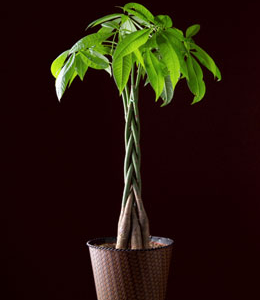Braided money plants look splendid and greatly compliments almost all home decor. You can learn how to braid a money tree yourself, instead of buying pre-braided and pricey plants...

The money tree or money plant
Pachira aquatica, is a tropical wetland species of plant, which is native to Central and South America. The plant can flourish to its fullest when allowed to grow in indirect sunlight and in humid conditions. The money tree has thick, fibrous stems, which can be easily manipulated into braids. The braided stems, add an aesthetic charm to the plant, making them look exotic. These plants are available in miniature bonsai sizes as well as tall and sturdy versions. Some can grow as tall as 7-8 feet while being grown in an artificial environment, such as at nurseries, home gardens and greenhouses.
Braiding a Money Plant at Home
Step 1
Your first step requires that you make sure that the money plant is still young and supple. The shoots must not be tampered with until they reach about 14 inches in height. Braiding the shoots prematurely can cause permanent retardation to the growth of the plant. It can also cause the shoots to scar, which will remain even after the plant attains maturity.
Step 2
You may braid the money plant once the shoots are adequately long and there are at least 3-5 shoots growing. You will need to start from the base of the shoot where the plant stems begin to emerge. You will need to take two shoots per hand and keep the central shoot as it is if there are 5 shoots present in your plant.
Step 3
Now gently begin to make a normal French plait, by twisting the money plant shoots over each other. You will need to lean over the plant, while you are attempting to braid the stems. This will help you untangle the leaves on the upper parts of the plant, while you're twisting the shoots at the lower half of the plant with your hands.
Step 4
Once you reach the leafy part of the plant, you will need to stop braiding by just a few inches. Thereafter you may secure the braid with some duct tape or a coir string. Do not wind the string or the tape too tightly around the plant, thereby providing some breathing space.
Step 5
Once you have braided the plant, you must place two stakes on either sides of the plant. This will provide support to the plant and prevent it from leaning sidewards. You may tie the shoots with the stake by using a string.
Step 6
Re-braiding the money plant must be done only after a few months have passed and the plant shoot has grown taller. You must open the string or duct tape and braid the new parts, until you reach the leafy parts. Repeat the entire procedure of tying the braid with some more coir strings. You might need to replace the older stakes with longer ones.
Precautionary Measures
- Once your money plant has reached a suitable height, you may remove the stakes and the strings, so as to let the plant grow freely. By then the shoots will harden up and the braid will become rather permanent. It is ill-advised to try to re-braid an older plant as the stems would simply not be able to withstand the force being applied on them. They will snap under pressure as these would no longer be as flexible as they originally were, while being young shoots.
- These plants do not require a lot of water. Keep them away from direct sunlight, as that would cause the plant to dehydrate. Leaves turning yellow is an indication of dehydration in money plants.
You can add a touch of novelty and uniqueness to your home by placing braided money plants in your garden and inside the house.






 The money tree or money plant Pachira aquatica, is a tropical wetland species of plant, which is native to Central and South America. The plant can flourish to its fullest when allowed to grow in indirect sunlight and in humid conditions. The money tree has thick, fibrous stems, which can be easily manipulated into braids. The braided stems, add an aesthetic charm to the plant, making them look exotic. These plants are available in miniature bonsai sizes as well as tall and sturdy versions. Some can grow as tall as 7-8 feet while being grown in an artificial environment, such as at nurseries, home gardens and greenhouses.
The money tree or money plant Pachira aquatica, is a tropical wetland species of plant, which is native to Central and South America. The plant can flourish to its fullest when allowed to grow in indirect sunlight and in humid conditions. The money tree has thick, fibrous stems, which can be easily manipulated into braids. The braided stems, add an aesthetic charm to the plant, making them look exotic. These plants are available in miniature bonsai sizes as well as tall and sturdy versions. Some can grow as tall as 7-8 feet while being grown in an artificial environment, such as at nurseries, home gardens and greenhouses.